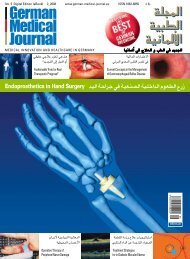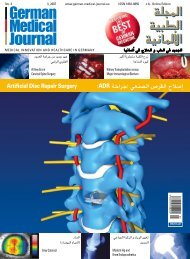Немецкий медицинский журнал Немецкий медицинский журнал
Немецкий медицинский журнал Немецкий медицинский журнал
Немецкий медицинский журнал Немецкий медицинский журнал
Create successful ePaper yourself
Turn your PDF publications into a flip-book with our unique Google optimized e-Paper software.
Coronary Stents<br />
THE JOURNAL OF MEDICINE FOR THE WORLDWIDE MED COMMUNITY<br />
Коронарные стенты<br />
follow-up, a greater absolute<br />
difference in cardiac death,<br />
myocardial infarction, TLR, and<br />
major adverse cardiac events<br />
(MACE) was observed in<br />
favour of EES, when compared<br />
with results at both 1- and<br />
2-year follow-up [31]. Similarly,<br />
in the larger SPIRIT III trial,<br />
the benefit of EES over PES<br />
persisted and even increased<br />
during follow-up; at 3 years,<br />
EES eventually lead to significant<br />
reduction in target vessel<br />
failure (TVF), target lesion<br />
failure (TLF), and MACE [31]<br />
On aggregate SPIRIT I-III have<br />
established superiority of EES<br />
over PES with respect to angiographic<br />
findings in low-risk profile<br />
patients. However, these<br />
trials were not powered for superiority<br />
in clinical end points.<br />
The SPIRIT IV trial assigned<br />
3,687 patients to receive EES<br />
(n=2,458) or PES (n=1,229)<br />
[36]. The principal findings<br />
revealed that EES resulted in a<br />
significant 38% relative reduction<br />
in the primary endpoint of<br />
TLF versus PES, and significant<br />
reduction in secondary<br />
end points of stent thombosis<br />
and myocardial infarction, but<br />
with no significant difference<br />
in mortality [36,37]. Similar<br />
results were obtained in the<br />
all-comers COMPARE trial. The<br />
primary endpoint was a composite<br />
of safety and efficacy<br />
within 12 months [33,34] (Table<br />
3). The composite of death,<br />
myocardial infarction and target<br />
vessel revascularization was<br />
lower with EES thanwith PES<br />
(6.2% vs. 9.1%; HR=0.69;<br />
95% CI 0.50-0.95) driven by<br />
a significant reduction of both<br />
TVR (6.0% vs. 2.4%; p=0.001)<br />
and myocardial infarction (5.4%<br />
vs. 2.8%; p=0.007). The rate<br />
of definite and probable stent<br />
thrombosis was significantly<br />
reduced among EES treated<br />
patients (0.7% vs. 2.6%;<br />
HR=0.26; 95%CI 0.11-0.64;<br />
p=0.002). The significant difference<br />
in stent thrombosis at<br />
12 months between the two<br />
groups was mainly attributable<br />
to early stent thrombosis.<br />
3. ZES versus EES<br />
In ESTROFA-2 de la Torre<br />
Hernandez et al analyzed 4,768<br />
patients treated with ZES<br />
(n=2,549) or EES (n=2,219);<br />
the cumulative incidence of<br />
definite/probable stent thrombosis<br />
for ZES was 1.3% at<br />
1 year and 1.7% at 2 years<br />
and for EES 1.4% at 1 year<br />
and 1.7% at 2 years (p=0.8),<br />
respectively [38|. Increments of<br />
definite thormbosis between<br />
the first and second year was<br />
0.2% and 0.25%, respectively.<br />
Ejection fraction (HR 0.97; 95%<br />
CI 0.95-0.99; p=0.008), stent<br />
diameter (HR 0.37; 95% CI<br />
0.17-0.81; p=0.01) and bifurcations<br />
(HR 2.1; 95% CI 1.14-3.7;<br />
p=0.02) emerged as predictors<br />
of thrombosis [38]. Serruys et<br />
убывающей следуют ЗВС(30,2 ±<br />
14,2%), ПВС (26,8 ± 15,8%), а СВС<br />
(6,4 ± 4,2%) (р













